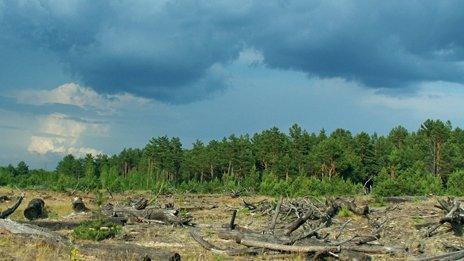Chernobyl's radioactive trees and the forest fire risk
- Published

Much of the 30km exclusion zone around the Chernobyl nuclear plant is pine forest, and some of it so badly contaminated that a forest fire could create a devastating radioactive smoke cloud.
Heading north from Kiev in Ukraine, you can see old ladies and their grand-daughters sitting waiting expectantly in the long grass, shaded from a sweltering sun, under the straight red eaves of tall, orderly Scots pines which line the road.
It is blueberry season, and they are selling them by the plastic pint glass. You could pull in to haggle, but Sergiy Zibtsev, a professor from the Forestry Institute at the Kiev University of Life Sciences does not recommend it. They are laced with radioactive strontium.
Berries are highly efficient at soaking up and storing radionuclides, huge quantities of which were dispersed over large parts of the Soviet Union and Western Europe by smoke plumes from the explosion.
Radiation measurement checks only take place in official markets, and usually only for caesium. As for the hundreds of makeshift fruit stalls, generally run by old ladies, these are never checked at all.
Having said this, the berries are not uniformly harmful. In an average pint of them, perhaps only a quarter will be contaminated. The main thing is to make sure you do not put them on your cereal every day.
Besides the blueberry sellers, the road on the fringes of the exclusion zone surrounding Chernobyl feels busier than when I first came here with Sergiy a couple of years ago.
There is a girl in high heels tottering along the verge, chatting on her iPhone. A large barley field ripples in the wind, ready for harvesting. A young couple shoot by on a moped.
This region is slowly getting back to normal, says Sergiy. People are returning to farm this once booming agricultural area.
It is happening inside the exclusion zone too. Chernobyl Forestry Enterprise is now planting small new pine stands which it plans to harvest in 80 years' time. But there are serious problems with the rest of Chernobyl's extensive pine plantations.
Pine damages easily. Wind blows it down. Insects infest it. Drought makes brush into perfect tinder which can all too easily catch fire. And these dying radioactive plantations are considered too dangerous and expensive to clear.
If ignited, one expert likens the potential effect to setting off a nuclear bomb in Eastern Europe. Wind could carry radioactive smoke particles large distances, not just in Ukraine, but right across the continent.
To help establish or disprove such hypotheses, Sergiy has come to Chernobyl to gather data about a very large fire which spread unchecked and destroyed a huge area of Scots pine in 1992. A colleague is preparing a scientific paper on the fire's consequences, which are still largely unknown.
Together, they hope to attract funding to model the danger represented by Chernobyl's forest.
If they can pinpoint the most vulnerable pine stands, the next step will be to persuade the Ukrainian government and other partners to invest in training and equipment to safeguard Chernobyl's firefighters, and perhaps eventually to clear parts of the forest considered to be at the most risk.
Firefighters in Chernobyl have one of the least enviable jobs in the world. They spend all day up rusty Soviet watchtowers, which sway in the wind like tin-box metronomes, and act as conductors to the huge lightning storms which swing across the land most afternoons in summer, often sparking fires.
When they spot a wildfire, the firefighters triangulate its location by radio. Teams jump aboard big, red, Soviet fire trucks, and lumber along cracked, overgrown roads to the source of the blaze.
Their equipment is very basic. They believe they know when they are fighting a radioactive fire - they experience a tingling, metallic sensation in their skin - but they do not fully understand the serious dangers of being exposed to superheated radioactive particles.
Their job description still belongs to heroic, Soviet ideals - they must put the blaze out, no matter the personal consequences.
Sergiy says more big wildfires in Chernobyl like the one in 1992 would be catastrophic for Ukraine's image, and potentially devastating for farmland right across Europe.
Lots of people are working on the problem, which continues with each new hot summer.
Sergiy and his colleagues need support, not just to save Chernobyl's firefighters from exposure to high doses of radiation, but to stop the particles migrating up into the air and away wherever the wind blows them, spreading the legacy of an accident which many people think we can already safely forget.
How to listen to From Our Own Correspondent:
BBC Radio 4: A 30-minute programme on Saturdays, 11:30 BST.
Second 30-minute programme on Thursdays, 11:00 BST (some weeks only).
BBC World Service:
Hear daily 10-minute editions Monday to Friday, repeated through the day, also available to listen online .
Read more or explore the archive at the programme website .